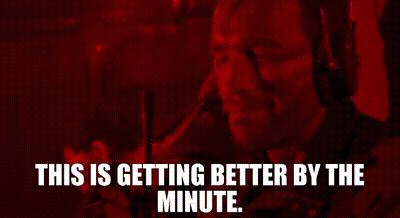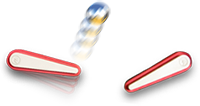Well this thread certainly got interesting.
Quoted from PaulCoff:Wish there was more from Compy
Sarcasm?
Please please please realize that that was dripping with sarcasm, and it did come off wrong when I made the joke. (There was no pre-order money, and anyone who plunked down for a translite got one post-haste)
So, a bit of background:
1. I was requested to do something that historically hadn't been done, but had been attempted many times. I had a number of weeks to get the base system working (I think I started in February and we were to show the game in March). We were literally putting in 12 hour days after working our day jobs to get this thing ready. I was literally SSHed into the game remotely and watching my changes through FaceTime with an iPhone on the playfield. It was scrappy at its finest. I'm in Austin, James and Paul are in Atlanta.
This is not atypical to other projects I've worked on with CMG. Pinball Circus was much the same way. Hey, get something going on a new board system a few weeks before expo, and we'll be assembling the rest of the playfield while you do it. The fact that you got to play any of these games when we were subjected to those timelines is astounding in and of itself. (Not looking for kudos here, I'm just remembering how the sausage got made, and it's awesome that it worked out).
To be clear, I'm not a legal representative for CMG. While they do call me one of the rings in that three ring circus, I'm mostly just a contractor. I come in and help where needed and volunteer my time. All of us put in our own time and money.
To those saying we're inexperienced: We all know who James is and what he has done for the industry/hobby. Paul has been involved for something like 15 years with Pins and Vids, all things Python Anghelo, and certainly the work he's doing at CMG. For me, I've shifted bits on more games than I can count for Spooky, Multimorphic, American Pinball, Valley Dynamo, Dutch Pinball, Haggis, Riot Pinball, CGC and more. In addition to doing the programming/operating system design for many of these projects, some projects required me to completely assemble games from scratch because they weren't in the same state as I was. I also did this when building my Wizard Blocks. I completely understand the point of "this game being put together by people with no experience" comes from a place of frustration and lack of updates.
2. Vegemite Nick is an insanely talented individual. When I was bright eyed and bushy tailed back in 2010-2011, I wanted to create my own pinball control system from scratch. He was one of the first people I turned to after seeing some of the work he did with Coconut Island. Visual Basic and pinball? What could be better! I cannot in good faith deny that he has been a huge help with this project. The issues he ran into during his build and what he communicated to us was extremely helpful and saved us weeks of tripping over obstacles. The same goes for the people that contributed physical parts to the build so we could have a reference game. I can only contribute time I have available to help CMG out. Pinball is not my full time job, I'm a hired gun in this industry (though many times it comes without the cash... what am I doing?).
========================================================
Now the meat and potatoes
========================================================
Last week I got some full playfield CADs and artwork printed on film and checked the scaling. This is basically the step I go through before I do whitewood cuts. I have to make sure things are to scale for the following:
1. Inserts. We have two options, we can either use original inserts, go with WMS/modern clear jewel style inserts, or just go full spooky and cut acrylic sheet. If you want RGB lighting, you have to use one of the last two options.
2. Mechs. This is a huge problem. Capcom engineered a lot of their own mechs. We can use WMS mechs with functioning EOS to cut down on the engineering/tooling costs and match the duty cycling as closely as possible to mimic the performance of the original game. With the longer ramp shots being in the center, I don't see this as much of an issue. (It would be an issue if the shot was at the end of the flipper bat)
4 bank drop targets - My vote and feedback I sent to the team is don't waste time engineering a 4 bank mech and use the stern equivalent if needed.
The gun handle - Getting tooling made for something like that really sucks because of the intricate detailing on the gun grip. These also have to be modeled in 3D and we have to outsource that. (I do all of my work in 2D... yeah, I know...)
Upper ball launch trough assembly - This was a completely custom part that will require a new weldment. It is similar to what was used on Diner.
Main ball trough assembly - I've subbed in footprints for traditional pinball life troughs. If push comes to shove, I have the footprints I used for the WMS troughs on Wizard Blocks.
Slot machine - Nothing too crazy there. At one point we considered stuffing an LCD there behind the plastics. But my personal opinion (and those of others) are that the mechanical reels are cooler.
Ramps - We've got the ramp king. Though new tooling has to be made.
Standup Targets - Capcom used custom opto targets. My vote is to replace these with common off the shelf standups. Better for us, better for you.
Ramp Spinners - Ok, these are really cool. They did use opto driven ramp spinners so the spinner has no friction against a microswitch or leaf assembly. With a bit of graphite, those spinners spin for days. This is easy replicate with a custom wire and a "C" style opto pair assembly like: https://www.pinballlife.com/ir-opto-sensor-high-sensitivity-4-leg.html
Pops - As you can see in one of the attached photos, 2 of the 3 mounting holes line up on the pop. My vote, again, is to switch to a standard WMS pop assembly, or the (better) Pinball Life single cut/mount solution like: https://www.pinballlife.com/classic-sterndata-eastsegacapcomalvin-gspookyheighway-thumper-bumper-housingbase.html
Cabinet - Capcom arguably had one of the nicest playfield slide/rail/cantilever systems out there. I would love to maintain this, but my vote (and what I shared with James and Paul) is to push and use a more typical WMS or even stern setup if it took more than a few weeks to come up with a solution.
Assembly - We've got several ideas about this. One thing I can say is that nobody on the team wants to set up a production line. We have multiple interested manufacturers, but it doesn't do much good to focus on "who" gets the gig yet until we have everything needed to build the darn thing.
=====================================================================
Anywho, I just figured I'd drop in and give you a bit more insight into what goes on here. My goals for the next few weeks:
1. Finish laying out the toolpaths and get some whitewoods cut to test fit and finish
2. Test different inserts (color, clear, acrylic) for fit and finish with standard white lighting, RGB, etc.
3. Ship a whitewood off to our printer for direct print and clear testing
Onward from that:
1. Get cabinet dimensions finalized and prototypes cut
2. Put the playfield we just cut above into the cabinet (use basic railing system because the focus is the build of many of the other parts)
3. Flat pack and ship items to James and Paul so that they can do what they need on their end (wiring harness design, further mechanical design, etc)
My role in most of these projects ranges from software/os guy (my forte) all the way to "whatever the hell explodes problem solver guy". I allocate time as I can between other contracts in the biz, day job and the mod work we do at 86Pixels.
Your criticisms are well-founded. I certainly appreciate any objectivity, but I certainly don't expect it ![]()
Hold me (and us) accountable by all means. Constructive criticisms always welcome!
-- Jimmy



 Hopkins, MN
Hopkins, MN
 Toronto, ON
Toronto, ON
 London
London
 Melbourne
Melbourne
 Zürich
Zürich

